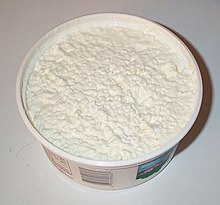Cottage cheese: Difference between revisions
removed one link (linkspam?) and one link (add to WikiBooks Recipies instead) |
|||
| Line 14: | Line 14: | ||
A 4 oz (113 g) serving has approximately 120 calories, 5 g fat (3 g saturated), 3 g carbohydrates, and 14 g protein. |
A 4 oz (113 g) serving has approximately 120 calories, 5 g fat (3 g saturated), 3 g carbohydrates, and 14 g protein. |
||
It also contains approximately 500 mg sodium, and 20 mg cholesterol. |
It also contains approximately 500 mg sodium, and 20 mg cholesterol. |
||
Manufacturers also Produce low-fat and non fat varieties. a fat free kind of a similar serving size has 80 calories, 0g fat (0g saturated), 6g carbohydrates, and 14g protein. |
|||
To compensate the flavor, low-fat and non fat ones tend to have more sugar in it. They also produce very low sodium kinds that consumers can add salt as much as they want. |
|||
==See Also== |
==See Also== |
||
Revision as of 23:25, 24 August 2007

Cottage cheese is a cheese curd product with a mild flavor. It is drained, but not pressed so some whey remains. The curd is usually washed to remove acidity giving sweet curd cheese. It is not aged or colored. Different styles of cottage cheese are made from milks with different fat levels and in small curd or large curd preparations. Cottage cheese which is pressed becomes hoop cheese, farmer cheese, pot cheese or queso blanco.
Cottage cheese is eaten straight where it is like the curds of the nursery rhyme food "curds and whey". It is also eaten in salads, with fruit or as an ingredient in recipes like jello salad and various desserts, such as cottage doubles, a ready-made package with cottage cheese and fruit preserves. Also, it can be used to replace grated cheese or ricotta cheese in most recipes (such as Lasagna). It is popular among dieters and some health food devotees. Cottage cheese is a favorite food among bodybuilders for its high content of casein protein while being relatively low in fat.
Curd Size
The curd size is the size of the "chunks" in the cottage cheese. Sometimes large curd cottage cheese is called "chunk style." The two major types of cottage cheese are small curd, high-acid cheese made without rennet, and popular large curd, low-acid cheese made with rennet. Rennet is a substance that speeds curdling and keeps the curd that forms from breaking up easily. Adding rennet shortens the cheesemaking process, resulting in a lower acid and larger curd cheese, and reduces the amount of curd poured off with leftover liquid (the whey).[1]
Nutrition
Cottage cheese is low in fat and carbohydrates while high in protein. It is quite beneficial for body builders as well as growing children.
A 4 oz (113 g) serving has approximately 120 calories, 5 g fat (3 g saturated), 3 g carbohydrates, and 14 g protein. It also contains approximately 500 mg sodium, and 20 mg cholesterol.
Manufacturers also Produce low-fat and non fat varieties. a fat free kind of a similar serving size has 80 calories, 0g fat (0g saturated), 6g carbohydrates, and 14g protein. To compensate the flavor, low-fat and non fat ones tend to have more sugar in it. They also produce very low sodium kinds that consumers can add salt as much as they want.
See Also
References
- ^ "Making Cottage Cheese at Home 1977" (PDF). UNITED STATES DEPARTMENT OF AGRICULTURE HOME AND GARDEN BULLETIN NUMBER 129. Retrieved 2007-07-22.
External links
